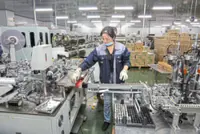
US President Donald Trump. — AP
UNITED States President Donald Trump has long been a staunch advocate of import tariffs, proudly calling himself the “Tariff Man” and asserting that “tariff” is “the most beautiful word in the dictionary”.
During his first term, Trump significantly disrupted the multilateral trading system by raising tariffs on Chinese imports and undermining the World Trade Organisation. But the size and scope of the tariffs he has imposed since his return to the White House have shocked the world.
Defenders of Trump’s trade policies argue that his tariff threats are merely a negotiating tactic and will ultimately benefit the United States economy.
But his recent actions, including his plan to impose “reciprocal” tariffs, matching those imposed by other countries on US goods, suggest that, unlike in his first term, he is fully committed to his protectionist trade agenda.
Trump’s ultimate goal, however, remains unclear. He seems to have embraced the deeply misguided idea that imports are inherently harmful.
To paraphrase French economist Frederic Bastiat, if exports are good and imports are bad, then the world’s freight ships should be loaded with exports and sent out to sea to dump their cargo overboard.
From a global perspective, tariffs mostly do more harm than good. While some argue that they contribute to national security, the reality is that tariffs raise costs and lower the quality of domestic production, undermining the very economies they are meant to protect.
Consider, for example, shipbuilding. Constructing an average-sized ocean-going ship costs four to six times more in the United States than in Japan or South Korea. A ship that costs US$55mil to build in China would cost US$333mil in the United States.
While some may justify these cost differences on national-security grounds, one must wonder:
Wouldn’t the United States Navy be far stronger if it could acquire four times as many ships by purchasing them abroad? Economists have rightly criticised Trump’s trade agenda. But many Trump supporters wrongly believe that America’s trading partners will bear the brunt of his tariffs.
In reality, the economic burden on the United States will be even greater and is expected to keep growing. In addition to the prohibitively high cost of replacing imports with domestic production, retaliatory tariffs are bound to drive up the cost of imported goods.
Beyond these direct costs, the Trump administration’s policies and rhetoric have fuelled uncertainty among American producers and consumers.
With roughly two-thirds of US imports consisting of raw materials essential for domestic manufacturing, manufacturers now face the prospect of rising costs for critical inputs. Many are already scrambling to secure alternative suppliers, often at higher prices, or stockpiling to hedge against future disruptions.
Compounding these challenges, shipments already en route to the United States face potential delays and higher customs duties.
Consequently, companies are putting off investment decisions, waiting for greater clarity before committing to long-term plans. This policy uncertainty is taking a particularly heavy toll on domestic industries that rely on foreign producers.
For example, Trump has threatened to impose a staggering 200% tariff on alcoholic beverages imported from the European Union. In response, lobbying efforts by companies seeking exemptions have surged.
Higher input costs inevitably lead to job losses in industries that rely on those materials. Trump’s tariffs are already upending the United States auto industry, potentially driving up the price of each new car by thousands of dollars.
And since building a new auto assembly plant in the United States could take up to seven years, a significant increase in domestic production remains years away.
These disruptions could have far-reaching macroeconomic consequences. Consumer confidence in the United States has plummeted to its lowest level since 2022, driven largely by fears that Trump’s protectionist policies will boost inflation.
His trade war has triggered a stock market sell-off, as investors worry about its impact on domestic industries and the potential loss of key trade partnerships.
Ironically, Trump’s promises to curb inflation played a major role in his election victory. But as economists Mickey D. Levy and Michael D. Bordo note, higher tariffs will have the opposite effect, slowing economic activity, increasing unemployment and driving consumer prices even higher.
Unsurprisingly, the outlook for the United States economy is growing increasingly bleak. The Organisation for Economic Co-operation and Development (OECD) recently revised down its US growth forecasts, warning that “trade conflict” could stifle economic activity and lead to higher inflation.
US growth is now expected to slow from 2.8% in 2024 to 2.2% in 2025 and 1.6% in 2026. The outlook for Canada and Mexico, the primary targets of Trump’s tariffs, is even more dire, with Canadian growth projected to slow to 0.7% and Mexico potentially entering a recession.
But the consequences of Trump’s reckless trade war extend far beyond North America. The OECD also adjusted its global growth forecast, predicting a slowdown from 3.2% last year to 3.1% in 2025 and 3% in 2026.
Whether this trend can still be reversed is unclear. The uncertainty caused by Trump’s policies could push the United States into recession, a scenario that appears increasingly likely, while retaliatory measures by other countries will compound the damage.
Given the growing risk of further escalation, the OECD’s projections may, in hindsight, prove woefully optimistic. — The Jakarta Post/ANN
Anne O. Krueger, a former World Bank chief economist, is a senior research professor of international economics at the Johns Hopkins University School of Advanced International Studies and a senior fellow at the Centre for International Development at Stanford University. The views expressed here are the writer’s own.










































